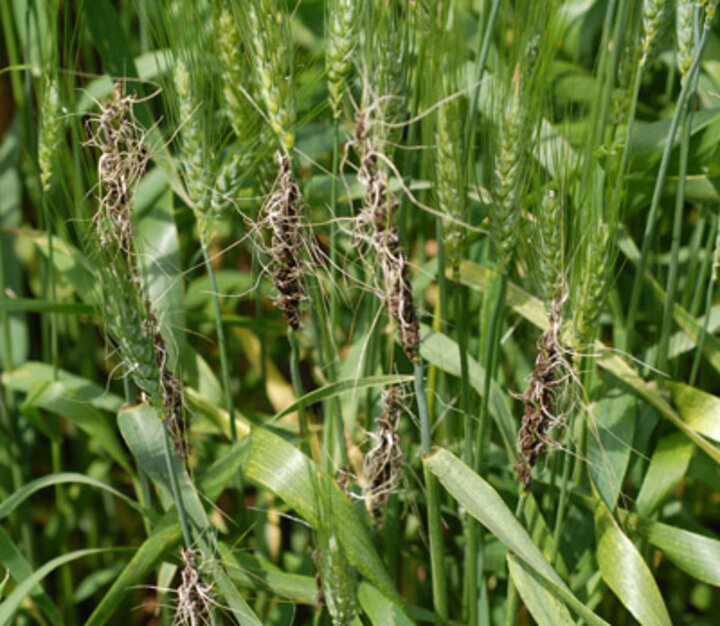|
Table I. Wheat seed treatment fungicides. |
||||
|
Trade Name |
Active Ingredient/s |
Rate |
Application Method |
Fungi/Diseases Controlled |
|
Allegiance -FL |
metalaxyl |
0.75 |
water-based slurry |
Pythium damping off |
|
Apron XL LS |
mefenoxam |
0.0425 - 0.085 |
slurry |
Pythium damping off |
|
Baytan 30 For use |
Triadimenol |
0.75 - 1.5 |
slurry |
Smuts, foot rot, take-all, powdery mildew, leaf rust, stripe rust |
|
Captan |
captan |
1.5 - 4 |
slurry |
Seed and seedling rots, not bunt or smut |
|
Charter |
triticonazole |
3.1 |
slurry |
Smut, bunt, seedling blights, Fusarium crown and root rot, seed-borne Fusarium |
|
Cruiser Extreme |
thiamethoxam |
See labels for Maxim XL, Apron XL, and Dynasty |
See labels for Maxim XL, Apron XL, and Dynasty |
Broad spectrum |
|
Dividend Extreme |
difenoconazole |
1 - 4 |
slurry |
Broad spectrum |
|
Dividend XL RTA |
difenoconazole |
2.5 - 10 |
slurry |
Broad spectrum |
|
Dynasty |
Azoxystrobin |
0.153 - 0.382 |
slurry |
Damping off, bunt |
|
Kodiak biological fungicide |
Bacillus subtilis |
0.05 - 0.1 oz |
slurry |
Rhizoctonia, Fusarium |
|
Maxim 4 FS |
fludioxonil |
0.08 - 0.16 |
slurry |
Fusarium, Rhizoctonia, Helminthosporium, Aspergillus, Penicillium |
|
Maxim XL |
fludioxonil |
0.167 - 0.334 |
slurry |
Fusarium, Rhizoctonia, Pythium, Aspergillus, Penicillium, bunt |
|
Raxil MD |
tebuconazole |
5 - 6.5 |
slurry |
Broad spectrum |
|
Raxil MD Extra |
tebuconazole |
5 |
slurry |
Broad spectrum |
|
Raxil MD Extra W |
imidacloprid |
5.14 |
slurry |
Broad spectrum, includes the insecticide imidacloprid |
|
Raxil MD_W |
imidacloprid |
5 |
slurry |
Broad spectrum |
|
Raxil-Thiram |
tebuconazole |
3.5 - 4.6 |
slurry |
Broad spectrum |
|
Raxil XT |
tebuconazole |
0.5 lb pouch/40-50 hundredweights of seed; add 0.5 lb pouch of colorant |
slurry |
Broad spectrum |
|
42-S Thiram |
thiram |
2 |
slurry |
Broad spectrum |
|
Vitavax -34 |
carboxin |
2 - 3 |
slurry |
Loose smut, common bunt |
|
RTU-Vitavax-Thiram |
carboxin |
5 – 6.8 |
Commercial seed treatment or pour-on hopper-box application |
Broad spectrum |
|
Fungicides listed represent the best information available. Reference to commercial products or trade names is made with the understanding that no discrimination is intended and no endorsement by the University of Nebraska–Lincoln Extension is implied. |
||||
Seed Fungicides Offer Early Protection for 2009 Wheat Crop
Explore our full collection of CropWatch articles.
Explore Articles


